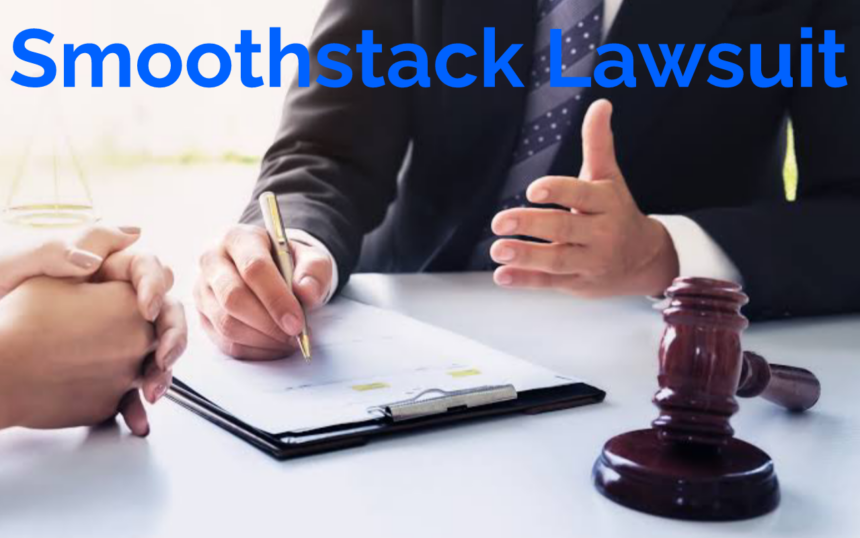The Genesis of the Smoothstack Lawsuit
The Smoothstack lawsuit has garnered significant attention within the tech industry and beyond. At its core, this legal battle stems from allegations that have led to a complex and multifaceted case. To fully understand the implications of this lawsuit, it’s essential to delve into its origins. Smoothstack, a prominent IT staffing and training firm, has faced accusations of contractual violations, employment malpractices, and other grievances raised by former employees and clients.
The initial spark for the lawsuit came when several ex-employees claimed that Smoothstack had breached their contractual agreements, leading to financial and professional detriment. These allegations quickly snowballed, capturing the interest of media outlets and industry watchdogs. The lawsuit’s commencement was marked by a series of legal filings, each detailing various aspects of the claims against Smoothstack. These documents provided a window into the contentious relationship between the company and its former associates, setting the stage for a protracted legal battle.
Key Allegations and Parties Involved
As with any lawsuit, the specifics of the Smoothstack case revolve around the allegations leveled against the company. These claims can be broadly categorized into issues concerning employment contracts, workplace conditions, and alleged fraudulent practices. Former employees have accused Smoothstack of enforcing restrictive clauses that hindered their career progression and violated labor laws. These contractual disputes have been a focal point, with plaintiffs arguing that they were misled about the terms of their employment.
Additionally, the lawsuit has implicated several key figures within Smoothstack’s leadership. Executives and managers have been named in legal documents, accused of perpetuating policies that allegedly exploit employees. The involvement of high-ranking officials underscores the seriousness of the claims and adds a layer of complexity to the proceedings.
The plaintiffs, on the other hand, include a diverse group of former employees, ranging from entry-level technicians to mid-level managers. This variation among the plaintiffs highlights the widespread nature of the grievances and suggests systemic issues within the company’s operational framework.
The Legal Proceedings and Timeline
Understanding the Smoothstack lawsuit requires a comprehensive look at the legal proceedings and the timeline of events. The lawsuit officially began when the initial complaint was filed in a federal court, outlining the plaintiffs’ claims and seeking legal redress. This filing marked the beginning of a highly publicized case that would unfold over several months, if not years.
Key milestones in the lawsuit’s timeline include preliminary hearings, where both parties presented their initial arguments. These hearings set the stage for more detailed examinations of the evidence and witness testimonies. Discovery phases followed, during which both sides gathered and exchanged pertinent information related to the case. This phase was crucial in uncovering potential evidence that could sway the outcome of the lawsuit.
As the case progressed, several motions were filed by both the plaintiffs and the defense. These motions aimed to either dismiss certain claims, compel the production of additional evidence, or seek summary judgments on specific aspects of the case. Each motion added a layer of strategy to the legal battle, with both sides maneuvering to strengthen their positions.
Implications for Employees and the Tech Industry
The Smoothstack lawsuit has far-reaching implications, particularly for employees within the tech industry. One of the primary concerns raised by the case is the enforceability of restrictive employment contracts. Many tech companies deploy non-compete clauses and other contractual stipulations to protect their business interests. However, the allegations against Smoothstack suggest that these clauses can sometimes be overreaching and detrimental to employees’ career mobility.
Should the plaintiffs succeed in their claims, it could set a precedent for the tech industry, prompting companies to reassess and potentially revise their employment contracts. This could lead to more favorable conditions for employees, promoting greater job mobility and fairer labor practices. Conversely, a ruling in favor of Smoothstack might reinforce the status quo, allowing companies to maintain stringent contractual controls over their workforce.
Beyond employment contracts, the lawsuit also touches on workplace conditions and employee treatment. Allegations of exploitative practices and hostile work environments could prompt broader discussions about workplace ethics within the tech sector. Companies might be encouraged to adopt more transparent and equitable policies to foster a positive work culture and avoid potential legal pitfalls.
Financial and Reputational Consequences for Smoothstack
The financial and reputational stakes for Smoothstack in this lawsuit are significant. Legal battles of this magnitude often entail substantial legal fees and potential settlement costs. Should Smoothstack be found liable for the alleged breaches, the financial repercussions could be severe, affecting the company’s profitability and operational stability.
Moreover, the lawsuit has already impacted Smoothstack’s reputation. Media coverage of the case has brought negative attention to the company, potentially deterring prospective clients and partners. Reputation is a critical asset in the tech industry, where trust and credibility are paramount. The ongoing litigation could undermine Smoothstack’s standing within the industry, leading to a loss of business opportunities and a decline in market position.
The reputational damage extends beyond external perceptions. Internally, the lawsuit might affect employee morale and retention. Current employees witnessing the legal turmoil may experience uncertainty and dissatisfaction, prompting them to seek opportunities elsewhere. This potential exodus of talent could further strain Smoothstack’s operations and hinder its ability to attract top-tier professionals in the future.
Legal Strategies and Defense Arguments
In responding to the lawsuit, Smoothstack’s legal team has employed a range of strategies to counter the allegations. A key element of their defense is challenging the veracity of the plaintiffs’ claims. Smoothstack has argued that the contractual agreements were consensual and adhered to legal standards. The company contends that the plaintiffs were fully aware of the terms and conditions of their employment, and any dissatisfaction arose from misunderstandings or miscommunications.
Additionally, Smoothstack has sought to discredit the plaintiffs’ accounts by presenting evidence of satisfactory employment records and positive performance reviews. By highlighting instances where the plaintiffs seemingly endorsed the company’s practices, Smoothstack aims to undermine the credibility of their allegations.
Another critical aspect of the defense strategy involves questioning the jurisdiction and applicability of certain legal claims. Smoothstack’s lawyers have contended that some of the allegations fall outside the scope of the court’s authority or are not supported by relevant labor laws. These jurisdictional challenges are designed to narrow the scope of the lawsuit and reduce the potential liabilities faced by the company.
Potential Outcomes and Their Ramifications
The potential outcomes of the Smoothstack lawsuit are varied, each carrying distinct ramifications for the involved parties and the broader industry. One possible outcome is a settlement agreement, wherein Smoothstack and the plaintiffs reach a mutually acceptable resolution outside of court. Settlements often involve financial compensation for the plaintiffs and may include provisions for policy changes within the company. While a settlement avoids a protracted legal battle, it can still have significant financial and reputational consequences for Smoothstack.
If the case proceeds to trial, a verdict in favor of the plaintiffs could result in substantial damages awarded to the former employees. Such a ruling would not only impact Smoothstack financially but also set a legal precedent that could influence future employment practices within the tech industry. Companies might become more cautious in drafting employment contracts, ensuring they comply with legal standards to avoid similar lawsuits.
Conversely, a ruling in favor of Smoothstack would reinforce the company’s contractual practices and potentially deter future legal challenges from disgruntled employees. However, the public scrutiny and negative publicity generated by the lawsuit might still linger, affecting the company’s long-term reputation and business prospects.
Read More: It Is Not Wisdom But Authority That Makes A Law. T – Tymoff
Broader Legal and Ethical Considerations
The Smoothstack lawsuit raises broader legal and ethical considerations that extend beyond the immediate parties involved. At the heart of the case is the balance between protecting business interests and ensuring fair treatment of employees. This delicate equilibrium is a recurring theme in employment law, particularly within industries characterized by high competition and rapid innovation.
Legal experts and industry analysts are closely monitoring the case to gauge its implications for labor laws and corporate governance. The lawsuit highlights the need for clear and enforceable employment contracts that safeguard both employer and employee rights. It also underscores the importance of fostering ethical workplace practices that promote transparency, equity, and mutual respect.
The ethical considerations extend to the role of corporate leadership in shaping company culture. Executives and managers are responsible for setting the tone and establishing policies that reflect the company’s values. The allegations against Smoothstack suggest a disconnect between leadership intentions and employee experiences, prompting a reassessment of leadership accountability and ethical standards within the tech industry.
Conclusion: Navigating the Road Ahead
As the Smoothstack lawsuit continues to unfold, its implications for the company, its employees, and the broader tech industry remain uncertain. The case serves as a reminder of the complexities inherent in employment relationships and the importance of upholding fair and lawful practices. For Smoothstack, navigating the road ahead will require careful legal strategy, transparent communication, and a commitment to addressing the underlying issues raised by the lawsuit.
For other tech companies, the Smoothstack case offers valuable lessons in managing employment practices and mitigating legal risks. By fostering a positive work environment and ensuring compliance with labor laws, companies can build a foundation of trust and resilience that withstands legal scrutiny.
Ultimately, the Smoothstack lawsuit underscores the evolving landscape of employment law and the ongoing quest for balance between business imperatives and employee rights. As the tech industry continues to grow and innovate, these legal and ethical considerations will remain at the forefront, shaping the future of work for years to come.



